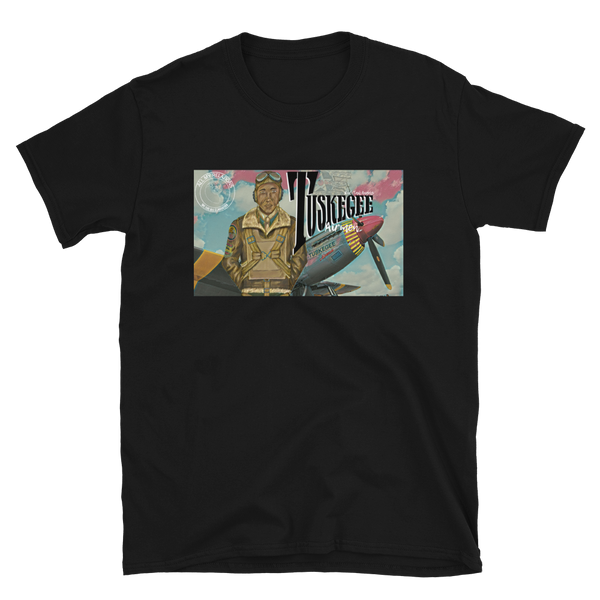




Tuskegee Airmen
Regular price
$20.00
The Tuskegee Airmen were a group of African-American military pilots (fighter and bomber) who fought in World War II. They formed the 332nd Fighter Group and the 477th Bombardment Group of the United States Army Air Forces. The name also applies to the navigators, bombardiers, mechanics, instructors, crew chiefs, nurses, cooks and other support personnel.
All black military pilots who trained in the United States trained at Moton Field, the Tuskegee Army Air Field and were educated at Tuskegee University, located near Tuskegee, Alabama. The group included five Haitians from the Haitian Air Force, and one pilot from Trinidad. It also included a Hispanic or Latino airman born in the Dominican Republic.
Although the 477th Bombardment Group trained with North American B-25 Mitchell bombers, they never served in combat. The 99th Pursuit Squadron (later, 99th Fighter Squadron) was the first black flying squadron, and the first to deploy overseas (to North Africa in April 1943, and later to Sicily and Italy). The 332nd Fighter Group, which originally included the 100th, 301st and 302nd Fighter Squadrons, was the first black flying group. It deployed to Italy in early 1944. In June 1944, the 332nd Fighter Group began flying heavy bomber escort missions and, in July 1944, with the addition of the 99th Fighter Squadron, it had four fighter squadrons.
The 99th Fighter Squadron was initially equipped with Curtiss P-40 Warhawk fighter-bomber aircraft. The 332nd Fighter Group and its 100th, 301st and 302nd Fighter Squadrons were equipped for initial combat missions with Bell P-39 Airacobras (March 1944), later with Republic P-47 Thunderbolts (June–July 1944) and finally with the aircraft with which they became most commonly associated, the North American P-51 Mustang (July 1944). When the pilots of the 332nd Fighter Group painted the tails of their P-47s red, the nickname "Red Tails" was coined. The red markings that distinguished the Tuskegee Airmen included red bands on the noses of P-51s as well as a red rudder; the P-51B and D Mustangs flew with similar color schemes, with red propeller spinners, yellow wing bands and all-red tail surfaces.
The Tuskegee Airmen were the first African-American military aviators in the United States Armed Forces. During World War II, black Americans in many U.S. states were still subject to the Jim Crow laws and the American military was racially segregated, as was much of the federal government. The Tuskegee Airmen were subjected to discrimination, both within and outside the army.
Source Wiki
You've now found the staple t-shirt of your wardrobe. It's made of a thicker, heavier cotton, but it's still soft and comfy. And the double stitching on the neckline and sleeves add more durability to what is sure to be a favorite!
• 100% ring-spun cotton
• Sport grey is 90% ring-spun cotton, 10% polyester
• Dark heather is 65% polyester, 35% cotton
• 4.5 oz/y² (153 g/m²)
• Pre-shrunk
• Shoulder-to-shoulder taping
• Quarter-turned to avoid crease down the center
All black military pilots who trained in the United States trained at Moton Field, the Tuskegee Army Air Field and were educated at Tuskegee University, located near Tuskegee, Alabama. The group included five Haitians from the Haitian Air Force, and one pilot from Trinidad. It also included a Hispanic or Latino airman born in the Dominican Republic.
Although the 477th Bombardment Group trained with North American B-25 Mitchell bombers, they never served in combat. The 99th Pursuit Squadron (later, 99th Fighter Squadron) was the first black flying squadron, and the first to deploy overseas (to North Africa in April 1943, and later to Sicily and Italy). The 332nd Fighter Group, which originally included the 100th, 301st and 302nd Fighter Squadrons, was the first black flying group. It deployed to Italy in early 1944. In June 1944, the 332nd Fighter Group began flying heavy bomber escort missions and, in July 1944, with the addition of the 99th Fighter Squadron, it had four fighter squadrons.
The 99th Fighter Squadron was initially equipped with Curtiss P-40 Warhawk fighter-bomber aircraft. The 332nd Fighter Group and its 100th, 301st and 302nd Fighter Squadrons were equipped for initial combat missions with Bell P-39 Airacobras (March 1944), later with Republic P-47 Thunderbolts (June–July 1944) and finally with the aircraft with which they became most commonly associated, the North American P-51 Mustang (July 1944). When the pilots of the 332nd Fighter Group painted the tails of their P-47s red, the nickname "Red Tails" was coined. The red markings that distinguished the Tuskegee Airmen included red bands on the noses of P-51s as well as a red rudder; the P-51B and D Mustangs flew with similar color schemes, with red propeller spinners, yellow wing bands and all-red tail surfaces.
The Tuskegee Airmen were the first African-American military aviators in the United States Armed Forces. During World War II, black Americans in many U.S. states were still subject to the Jim Crow laws and the American military was racially segregated, as was much of the federal government. The Tuskegee Airmen were subjected to discrimination, both within and outside the army.
Source Wiki
You've now found the staple t-shirt of your wardrobe. It's made of a thicker, heavier cotton, but it's still soft and comfy. And the double stitching on the neckline and sleeves add more durability to what is sure to be a favorite!
• 100% ring-spun cotton
• Sport grey is 90% ring-spun cotton, 10% polyester
• Dark heather is 65% polyester, 35% cotton
• 4.5 oz/y² (153 g/m²)
• Pre-shrunk
• Shoulder-to-shoulder taping
• Quarter-turned to avoid crease down the center
Size guide
| S | M | L | XL | 2XL | 3XL | |
| Length (inches) | 28 | 29 ¼ | 30 ¼ | 31 ¼ | 32 ½ | 33 ½ |
| Width (inches) | 18 | 20 | 22 | 24 | 26 | 28 |